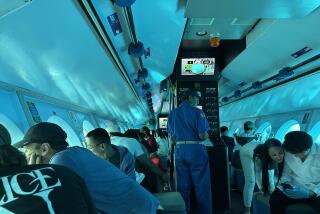Down but Not Out : Students’ Sub Fails to Rise in Test but Hopes Are Not Sunk
- Share via
The thing that swallowed two swimmers and kept dozens of others out of the water Tuesday in Westwood looked more like a whale than a shark.
The pedals in its belly were the real giveaway, though. A human-powered submarine was lurking on the bottom of the UCLA swimming pool.
With four days to go before casting off for submarine races along the coast of Florida, students launched a handmade yellow sub in the center of the campus for a shakedown cruise.
And down was the operative word, pilot Megan McArthur and pedaler Eric Krystkowiak discovered as the 15-foot fiberglass craft settled to the bottom.
While friends in a nearby engineering department lab struggled to finish an eight-bladed propeller, the students dove in and squeezed themselves into the 23-inch-wide submarine to check out electrical and oxygen systems and the craft’s flotation.
Two out of three was not bad, they said.
The submarine had sank like a rock to the bottom of the 12-foot-deep pool. More foam would have to be stuffed under its hull to improve flotation by creating a negative buoyancy, the 21-year-olds decided.
McArthur will steer the 400-pound submarine down a 100-meter straightaway course and then around a longer oval course when 50 colleges compete in races June 16 in Ft. Lauderdale. She will sit with her chin wedged between her knees, steering levers beneath her legs.
“I got to be pilot by default. I’m the one who fits,” said McArthur, a senior from San Jose. “It’s a good thing I’m not claustrophobic.”
Krystkowiak, a senior from Saugus, won the back-seat pedaling job by default too. He is the experienced bicyclist and triathlete among the six aerospace engineering students who have spent 15 months planning and building their submarine.
“He’s got the legs,” McArthur said.
Classmate Derek Leek, 22, of Walnut Creek got the submarine idea. It did not come from any of the complicated engineering texts and journals he and his friends read either.
“I saw an article about them in Popular Mechanics magazine,” he said.
Leek recruited friends Tom Weir, 22, Brian Clark, 19, and Kerri Wilkerson, 20, and they started work 15 months ago. They experimented as they tried out things they learned in class. “A submarine is a lot more similar than you think to an airplane,” Leek said.
The project came close to getting deep-sixed when a promised $15,000 construction grant from a local aerospace firm failed to materialize. The students ended up begging for donations of cash and things such as air bottles and parts.
Most of the submariners have kicked in several hundred dollars each to help pay the $6,500 it cost to construct the craft. They were still waiting Tuesday to learn whether the engineering department can contribute to the cost of their Florida trip.
Tuesday’s test attracted plenty of attention as the submariners rolled their craft across campus and hoisted it into the swimming pool, which they had reserved for three hours. One onlooker was Steve Novosad, a Navy recruiter who recently ended a six-year tour on the nuclear submarine George Washington Carver.
“Holy smokes, this is neat!” Novosad said.
Along with the buoyancy problem, the students also discovered a stuck latch on the submarine hatch. Breathing from scuba-diver air bottles that the crew will use during the race, students used wrenches to make repairs while the sub was on the bottom of the pool.
Recreational swimmers were impatiently lined up along the edge of the pool when the three-hour mock sea trial ended. The swimmers groaned when the rope hoisting the craft loudly snapped, dumping the submarine back into the water and sending students diving to retrieve it.
Students said they hope to test their finished propeller Thursday evening in the UCLA pool. On Friday, they plan to load the sub on a trailer and ship out, come what may.
Damn the torpedoes. Full speed ahead.
More to Read
Sign up for Essential California
The most important California stories and recommendations in your inbox every morning.
You may occasionally receive promotional content from the Los Angeles Times.














